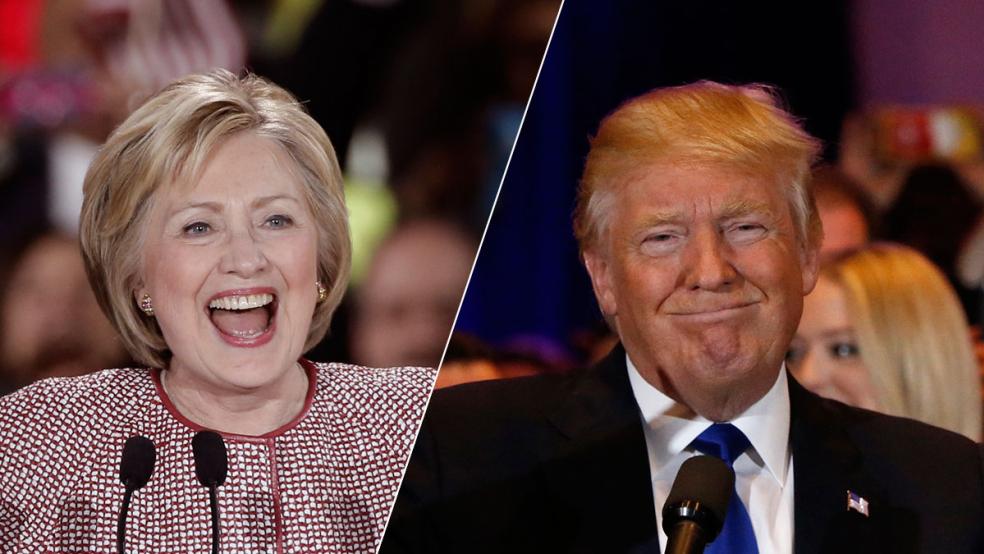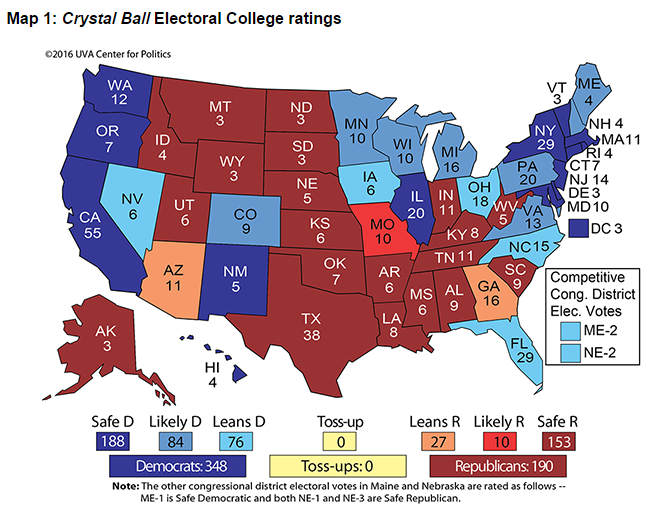Despite all the breathless headlines to the contrary, the presidential race between Hillary Clinton and Donald Trump isn’t really that close right now. A series of recent polls have showed a tightening of the popular vote, with the occasional survey showing Trump actually ahead. However, for a couple of reasons, it’s not actually all that helpful to look at national polls and try to draw conclusions about how things will stand when the polls close on Nov. 8.
First of all, for better or for worse, the U.S. does not hold a national election. A successful presidential candidate can actually win the presidency with fewer total votes than an opponent because of the way the Electoral College works. George W. Bush did it in 2000, and John F. Kennedy, arguably, did it in 1960. It’s not really that complicated. Landslide victories for a Republican across the Deep South, for example, yield just as many electoral votes as one-point victories for a Democrat in states like New York, California and the Pacific Northwest.
Related: With Clinton Campaigning Again, Trump Renews Attacks on Her Health
So even when the Real Clear Politics polling average shows Clinton ahead by just 1.8 percent nationally, and barely clinging to a 1.1 percent lead over Trump if third party candidates are included, it doesn’t indicate that the election is close to a coin flip at this point. In the fall of 2012, President Obama was polling just 0.4 percentage points ahead of Mitt Romney on average, and he went on to win the presidency comfortably, with 332 electoral votes to Romney’s 206.
None of this is to say that Trump can’t win the presidency. He can. The respected FiveThirtyEight.com election forecast model puts the odds right now at a little better than one-in-three. But the truth is that he faces a very challenging path to get to the 270 electoral votes he needs.
At the University of Virginia’s Center for Politics, Larry J. Sabato, Kyle Kondik and Geoffrey Skelley continue to argue that Clinton has by far the easier road to election, postulating what they refer to as “Fortress Obama” that Trump would have to conquer in order to find his way to the Oval Office.
“There are 359 electoral votes worth of states (and Nebraska’s Second District) that voted for Obama at least once,” they write. “Indiana, which Obama carried in a fluke in 2008, is already gone, which knocks Clinton’s total down to 348, where we have her right now.”
Related: Libertarian Gary Johnson Scores a Major Victory in His White House Bid
“The fortress’s outer ring of defenses — the Leans Democratic states — is made up of Florida (29 electoral votes), Iowa (6), Nevada (6), North Carolina (15), Ohio (18) and two electoral votes from congressional districts in Maine and Nebraska,” they continue. “If Trump can break through in all of those places, he gets to 266 — four short of the majority he needs. He would need one other state, coming from the Likely Democratic column — places like Colorado, Michigan, New Hampshire, Pennsylvania, Virginia, and Wisconsin. Trump is losing in those six states by an average of six points in the RealClearPolitics polling average, and Clinton has led 109 of 119 polls conducted in those states, combined, since last summer (Trump led just four, and there were six ties).”
Again, this doesn’t mean a Trump victory is impossible. It’s just unlikely. Writing at FiveThirtyEight.com today, David Wasserman of the Cook Political Report lays out a credible scenario under which Trump could snatch victory from Clinton in the Electoral College while losing the popular vote.
Should Hillary Clinton be sleeping easy? No. She’s facing about a 1-in-3 shot of losing to a man who the vast majority of the American people believe in unqualified to serve as president. But to say that the race is really neck-and-neck at this point seriously overstates the current state of play in Trump’s favor.






